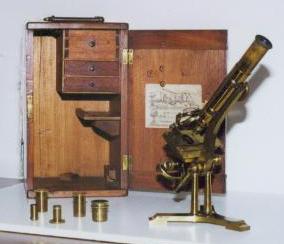
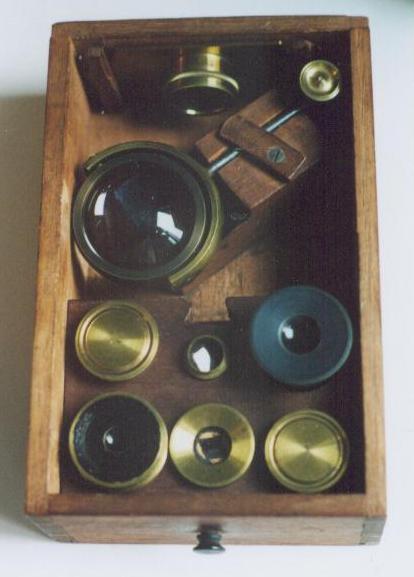
|
by Barry B. Miller, USA |
It's not often possible to look into the past history of an old microscope. But, now and then, we come across an instrument that has some clues to its past. I have such a microscope - an old Dancer that provides just enough information to keep me trying to unravel its mystery.
This is one of my favorite microscopes because, in my opinion, all Dancer microscopes are special due to the mystique associated with John Benjamin Dancer. The instrument is 14 inches (35.6 centimeters) high when fully extended. It comes in a polished wood case that has three drawers and a handful of accessories. The accessories include two eyepieces; two objectives; a live box; a condensing lens that fits into a dovetailed space in the stage; a wheel of stops that also fits into the dovetailed space; a polarizer and an analyzer. The polarizer screws into one of the openings in the wheel of stops and the analyzer screws into the top of the objectives. The following photographs show the microscope in its case, and the drawer containing accessories.
|
|
|
So, what is the mystery? Actually, there are three.
The first relates to an inscription on the base of the microscope. The inscription is as follows: “Presented to J. Hutchinson, Esq., by S. W. Williamson, March, 1847”. The question is - who were J. Hutchinson and S. W. Williamson? Thankfully, we at least know the approximate date in which the instrument was made from the date noted in the engraving. (The street address on the Dancer label is also helpful in this regard. It specifies 13 Cross Street, which would indicate that the instrument was made prior to 1847, as the 1847 instruments would have noted 43 Cross Street instead. It is, therefore, reasonable to assume that this microscope was actually made in the latter part of 1846, with the presentation to J. Hutchinson occurring some months later).
The second mystery relates to the three drawers that occur in the upper right-hand portion of the case. Normally, there would be no drawers with this model. Instead, there would be a removable box that holds the accessories, and that box would slip sideways into the upper right-hand area of the case. In fact, the ledge that would normally support the lower side of such a box is still present (see photograph below). So, how did it happen to be that there are three drawers in the case instead of the usual box?
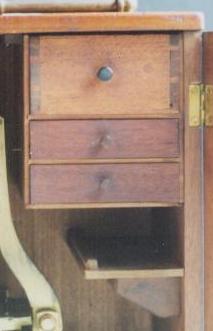
The third mystery relates to various areas of the drawers and case that have penciled-on handwritten notations. Is that writing of any significance? Who placed it there and when?
During the past four years, I have sought to find the answers. I contacted a number of individuals and organizations, all of whom were eager to help and offer suggestions. Among the suggestions made regarding Hutchinson and Williamson were:
I will never know for sure, but I think it is credible that Dr. Joseph Hutchinson and Samuel Walker Williamson were the persons whose names were engraved on the base of the microscope. They both lived in Cheetham Hill, which is not far from where the microscope was made, and both were listed in the Manchester and Salford Trade Directory for 1848.
What about the origin of the drawers? Were they installed at the outset by Mr. Dancer or were they added later on? It is known that early Dancer microscope cases sometimes have “blind holes” - their purpose being to accommodate the knobs of the accessory box or of the drawers. As can be seen in the photograph below, the drilled hole originally made for the accessory box appears on the left side of the door. To the right side of it are three vertically arranged drilled holes, made to accommodate the three drawer knobs. All four holes look rather similar, each having a little “pilot hole” in the center. The color and aging of the wood also have a similar appearance. Although all of the holes appear to be of similar age, I cannot definitively determine when they were drilled relative to each other. Therefore, I cannot say when the drawers were installed.
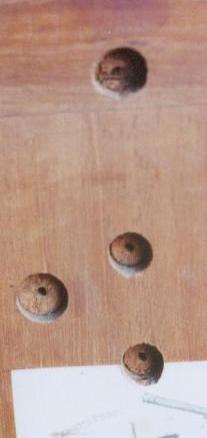
The third mystery relates to the handwritten scrawl that occurs on the drawers and case. The writing is hard to read as penciled notations do not show up very well against the dark wood. The handwriting, which is in script, is not very neat or skillfully done and may represent that of a young person. Also, it would seem unlikely that a more worldly person would want to deface an attractive microscope case, drawers, and the maker's trade label by writing his name and address numerous times.
The name that is written is Frank D. Hutchinson, Esq. A logical conclusion is that Frank D. Hutchinson is a descendant of J. Hutchinson. Although not all of the handwriting is legible, various other words can be made out. On one particular drawer is written “Septem 1923”. So, evidently, Frank D. Hutchinson owned the microscope at that time. There are places where “15” and “BK = 264” appear, the meaning of which is unclear. A particular notation that had no significance to me until just recently is “Hants”. It was by chance that I saw Hants written on an old microscope slide. I then followed up and learned that it is a place in England. Preceding the name “Hants” on the drawer is some other writing that looks, to the best that I can make out, like “Longopse Vine.” The first four letters (i.e., “Long”) are the most unmistakable but what follows them is not so clear. Perhaps, it represents a street name - Frank D. Hutchinson's home address? In a scan of the back of the largest drawer, I have lightened the wood a little attempting to make it easier to see the handwriting.
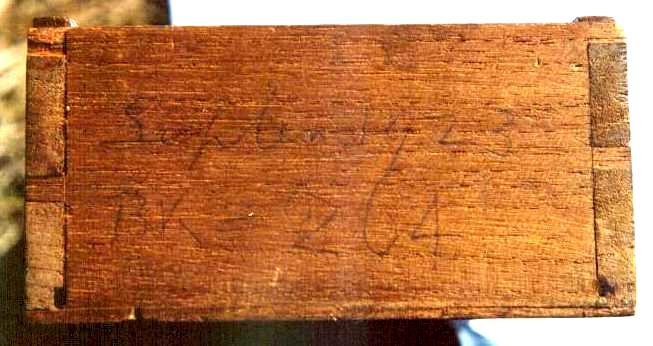
My attempt to learn more about this microscope's history is continuing. If anyone would like to offer their thoughts regarding the mysterious writing or other aspects of the microscope, I would be happy to hear from them.
All comments to the author Barry Miller are welcomed.
Acknowledgements:
My sincere thanks to the many persons who provided information in my attempt to learn more about the history of this microscope. These include: David Walker; Brian Darnton; Graham Marsh; Stella Lowe, Honorary Curator and Librarian, Manchester Literary and Philosophical Society; Jenny Wetton, Curator of Science of The Museum of Science & Industry in Manchester; and Paula Moorhouse, Librarian, Local Studies Unit, Department of Libraries and Theatres, Central Library, Manchester. I am also grateful to my wife, Marcia, who encouraged my persistence and made suggestions to improve the article.
References:
Bracegirdle, Brian. 1996. Notes on Modern Microscope Manufacturers. The Quekett Microscopical Club.
Bracegirdle, Brian. 1998. Microscopical Mounts and Mounters. The Quekett Microscopical Club.
Wetton, Jenny. 1991. John Benjamin Dancer: Manchester Instrument Maker. Bulletin of the Scientific Instrument Society. No. 29. pp. 4-8.
Please report any Web problems or offer general comments to the Micscape Editor.
Micscape is the on-line monthly magazine of the Microscopy
UK web
site at
Microscopy-UK